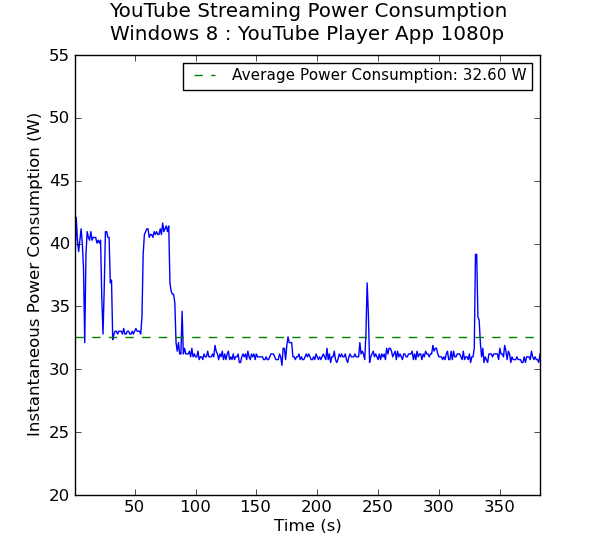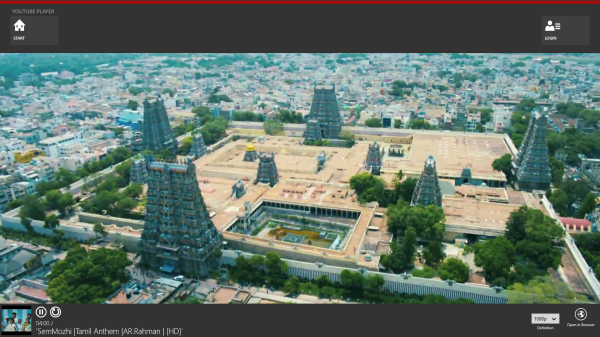Getting the Best out of an Ivy Bridge HTPC: Windows 8, madVR and More..
by Ganesh T S on January 20, 2013 3:00 PM EST- Posted in
- Home Theater
- Intel
- HTPC
- Ivy Bridge
- Windows 8
- Passive Cooling
Network Streaming Performance - YouTube
YouTube is one of the most popular video streaming services, and Google maintains a number of encodes for each stream. On platforms supporting Adobe Flash, FLV streams are available at resolutions ranging from 240p to 480p. HTML5 streams are either in WebM (for Firefox) or MP4 / H.264 (for Internet Explorer). WebM streams typically top out at 720p, while MP4 is the preferred format for 1080p. At higher resolutions, Adobe Flash also streams the MP4 version.
As expected, we get GPU acceleration when using Adobe Flash in Firefox on Windows 7. The debug OSD presents the requisite details.
HD YouTube Streaming using Adobe Flash in Mozilla Firefox on Windows 7
Windows 8 has an app for YouTube, 'YouTube Player' which allows for stream quality selection. Just like the Netflix app, there is no direct way to determine if GPU acceleration is being used.
HD YouTube Streaming using the YouTube Player App on Windows 8
We will rely on the power consumption at the wall to determine the efficiency of various ways to stream YouTube videos across different operating systems. Since the matrix of options is quite big, we present the graphs one at a time. All the graphs are on the same scale. Press the button below corresponding to the combination you want to compare the current graph against.

It can be seen that the Windows 8 YouTube Player App wins hands down. The stream being decoded is, in all probability, the 1080p H.264 version. Even when Adobe Flash is being used, Windows 8 seems to be more efficient compared to Windows 7. If you are on Windows, and prefer to use HTML5, it is better to avoid Mozilla Firefox because the WebM version consumes the most power at the wall (due to lack of hardware accelerated decode) while providing only a 720p stream. Once again, if YouTube forms a major part of your HTPC experience, an upgrade from Windows 7 to Windows 8 can be recommended.












138 Comments
View All Comments
lockdown571 - Monday, January 21, 2013 - link
Did you guys mention anywhere that most of the Metro apps included Netflix can't be controlled with a remote control and are thus unsuitable for most HTPC users? I realize the focus of this article was on performance, but what's the point if you can't actually control the application.zilexa - Monday, January 21, 2013 - link
Is the high price of a Core i3 HTPC (expensive CPU, mobo and fanless case) worth the benefits? I am considering to build my new HTPC. It will most likely be a AMD Brazos e2 1800 (zotac ad12).An Intel Core i3 55w/HD4000 is much pricier.. and I would need an expensive case. As HTPC the only benefit of an Intel Core i3 is it can work with MADVR while still being supersilent/fanless.
But if you just use XBMC, Youtube, Netflix, and don't care for MADVR, a much, much cheaper system is more then enough right? Plus you don't have framerate issues with the cheapy Brazos.
I do like this article, I have made 3 shopping lists, one for the Brazos/Zotac, one for exactly this setup (Core i3 2225/55W/HD4000) but different mobo and much cheaper case with a very silent fan and one for AMD but it lacks a motherboard since there are no FM2 mITX out there that i like.
I especially like the Intel setup because mobo's with mSATA are available, and its cool to be able to experiment with 8GB/dual channel and play with MADVR.
ganeshts - Monday, January 21, 2013 - link
Strongly suggest avoiding the Brazos because many tasks end up being CPU bound. You will have no luck playing 1080p60 material (becoming more and more common because of cheap cameras like the new GoPros) with that GPU.Go for the i3-3225 if you don't care about accurate refresh rate. You can go for a cheaper case and mobo, no issues. Main point of using passive chassis from Streacom is because it was built and described in the first part of the HTPC series.
zilexa - Monday, January 21, 2013 - link
Actually my dad has a Brazos E-450 and one of those small cams.. I thought it was 1080p60 because the htpc played it perfectly... must have been 1080p60.I would prefer an AMD based system build by myself instead of Zotac, but AMD lacks good mITX FM2 mobos and I would have to buy a 65w APU (A10-5700) and underclock it a lot to make sure my system is still absolutely quiet in my small living room during load. So it's Brazos, wich leads me to Zotac or Intel (I don't like the Arctic barebones using AMD mobile APUs, way too expensive and they have stuff I would never use like tv card).
About the i3-3225, I really dont need >3GHz if I just have Win8, XBMC, uTorrent and a browser right? would be a nice follow up test (!) to see how far you can underclock the i3-3225 and still be able to playback 1080p60 using dxva (not necessarily via MadVR)
If the i3 would work fine with a cheap but neat LC-Power LC-1320mi case and stay cool enough with a Scyte Kozuti cooler.. it might be supersilent..
but still, if you compare prices:
- Zotac AD12 + Crucial M4 SSD + 1x4GB = €313 (I live in Netherlands).
- i3 3225, Gigabyte GA-H77N-WIFI, Crucial 2x2GB 1,35volt DDR3-1600, Crucial m4 msata, LC Power LC-1320mi case and Scythe Kozuti cooler = €370
and 2x4GB DDR3 would make it €390.
It's 80 bucks more expensive and only adds 1080p60?? it will most likely not be able to support 4K.. if I spend this much money I still want to use it in 4 years..
I'll wait till the final part of this review for the 4K results.. Hurry up Ganesh :) if you have time, would a very short chapter about underclocking be possible?
zilexa - Monday, January 21, 2013 - link
-edit first sentence, the camera was 1080i30 someting, not 1080p60.ganeshts - Monday, January 21, 2013 - link
The only cheap 1080p60 action cam is the GoPro HD Hero 3 Black Edition, and it is around ~$400 here in the US. Everybody else is on 1080p30 or 720p60.720p60 is more stressful for madVR when displaying on to a 1080p screen.
What OS are you going to use? If it is Win 7, then, please spend the extra 80 bucks. (Not sure if Netflix is available yet in Netherlands, but the Win 7 version uses Silverlight and it is CPU intensive. Also, YouTube HD using Adone Flash is CPU intensive too). Unless you want to be on leading edge, I guess 4K will not be a concern at least for the next 2 - 3 years. 4K decode is possible on the Ivy Bridge, but output is not possible with most motherboards.
If you are going to run XBMC with other programs in the background, you will appreciate the extra CPU headroom provided by the i3.
As for underclocking - I think it is more trouble than it is worth. The CPU adjusts its clock frequency based on the load, and it only goes up to 3.3 GHz when we run Prime 95 or those sorts of loads. I will include a section on detailed CPU usage (including operating frequencies) in the next piece.
zilexa - Monday, January 21, 2013 - link
You actually convinced me. The Zotac/E2-1800 solution is definitely not futureproof. I was planning to buy the Gigabyte H77N-WIFI wich has dual-HDMI so perhaps, if the drivers can make use of it, it might be possible to experiment with 4K in the future. It also has WiDi, so already advantages over Zotac. Would be possible to create an 'office' room or office corner with a wireless touch display and keyboard. No more need for 2nd computer.Unfortunately Netflix is not working in NL, thats why torrents via rss or newsgroups are very, very popular;)
I sold my 780G based system including Silverstone ML02 case last weekend (still got €170!) cos I planned to buy the Zotac this week.. but I will wait and save some more... at least I will have plenty to watch on the macbook or when I get the i3 system :)
I planned on using win7 or win8. Also thinking about Ubuntu but no linux experience and I do want a fully working firefox browser and torrentclient with good rss support (utorrent) so I probably stick with Win8 because its just easy and fast.
A section about operating freqs would be nice. I am used to AMD Athlon X2 and had to use RMClock to get the CPU silent, Cool'n'Quiet didn't do that.
nellieboy - Monday, January 21, 2013 - link
ive recently upgraded my htpc .hfx classic case fanless silverstone psu already had. same processor as in this article but with asus p8z77-m and 8 gig samsung green ram .all works extremely well scary quiet.but the tv card i want blackgold 3600 is out of stock at the moment.while browsing the blackgold website it seems there is a problem starting this year with the epg not working in windows media center.turns out microsoft have not renewed the license for the epg .i dont know if they have plans to renew but it seems in europe at least were stuffed .microsoft will phase out wmc or at least no longer develop it . just something to think about shame really because that was the best part of wmc.heres the link http://shop.blackgold.tv/Support. this is only for terrestrial tv i think dont know about satellitetyvoyde - Monday, January 21, 2013 - link
my 3225 on a gigabyte h77n gets a wpi of 5.7 and 6.4.... obviously your 4.7 and 6.2 wpi are not the 'best'powerarmour - Monday, January 21, 2013 - link
My point also, I get 6.5/6.5 for graphics/gaming graphics :-http://img201.imageshack.us/img201/3023/captureqvl...
Though I am running the Haswell 15.31 2885 Beta drivers.